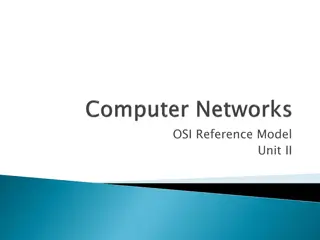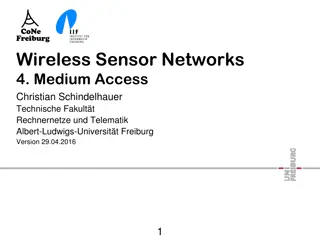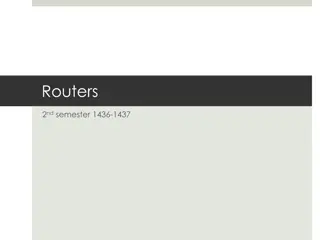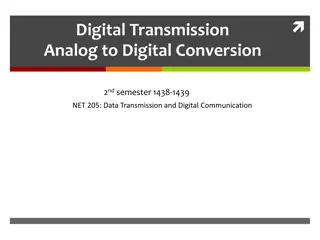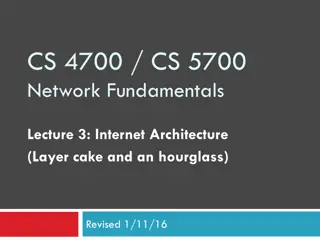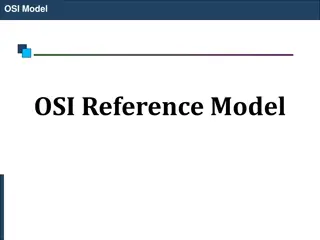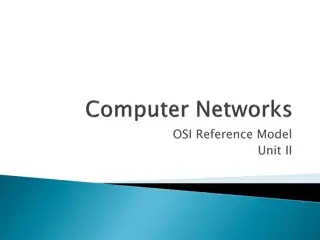
Understanding OSI Model: Layers, Functions, and Implementation
Explore the OSI model, a 7-layer architecture developed by ISO, for efficient data transmission worldwide. Learn about each layer's functionality, from the Physical Layer to the Data Link Layer, ensuring error-free communication between devices.
Download Presentation

Please find below an Image/Link to download the presentation.
The content on the website is provided AS IS for your information and personal use only. It may not be sold, licensed, or shared on other websites without obtaining consent from the author. If you encounter any issues during the download, it is possible that the publisher has removed the file from their server.
You are allowed to download the files provided on this website for personal or commercial use, subject to the condition that they are used lawfully. All files are the property of their respective owners.
The content on the website is provided AS IS for your information and personal use only. It may not be sold, licensed, or shared on other websites without obtaining consent from the author.
E N D
Presentation Transcript
StudyMafia.Org Osi Model Submitted To: Submitted By: Studymafia.org Studymafia.org
Table Contents Definition Introduction Layers of OSI Model Purpose of OSI Model Conclusion 2
Definition OSI stands for Open Systems Interconnection. It has been developed by ISO International Organization for Standardization , in the year 1984 3
Introduction It is a 7 layer architecture with each layer having specific functionality to perform. All these 7 layers work collaboratively to transmit the data from one person to another across the globe. 4
Layers of OSI Model Physical Layer (Layer 1) : The lowest layer of the OSI reference model is the physical layer. It is responsible for the actual physical connection between the devices. The physical layer contains information in the form of bits. It is responsible for transmitting individual bits from one node to the next. When receiving data, this layer will get the signal received and convert it into 0s and 1s and send them to the Data Link layer, which will put the frame back together. 6
Layers of OSI Model The functions of the physical layer are as follows: Bit synchronization: The physical layer provides the synchronization of the bits by providing a clock. Bit rate control: The Physical layer also defines the transmission rate i.e. the number of bits sent per second. Physical topologies: Physical layer specifies the way in which the different, devices/nodes are arranged in a network i.e. bus, star, or mesh topology. Transmission mode: Physical layer also defines the way in which the data flows between the two connected devices. 7
Layers of OSI Model Data Link Layer (DLL) (Layer 2) : The data link layer is responsible for the node-to-node delivery of the message. The main function of this layer is to make sure data transfer is error-free from one node to another, over the physical layer. When a packet arrives in a network, it is the responsibility of DLL to transmit it to the Host using its MAC address. 8
Layers of OSI Model The functions of the Data Link layer are : Framing: Framing is a function of the data link layer. It provides a way for a sender to transmit a set of bits that are meaningful to the receiver. Physical addressing: After creating frames, the Data link layer adds physical addresses (MAC address) of the sender and/or receiver in the header of each frame. Error control: Data link layer provides the mechanism of error control in which it detects and retransmits damaged or lost frames. 9
Layers of OSI Model The functions of the Data Link layer are : Flow Control: The data rate must be constant on both sides else the data may get corrupted thus, flow control coordinates the amount of data that can be sent before receiving acknowledgement. Access control: When a single communication channel is shared by multiple devices, the MAC sub-layer of the data link layer helps to determine which device has control over the channel at a given time. 10
Layers of OSI Model Network Layer (Layer 3) : The network layer works for the transmission of data from one host to the other located in different networks. It also takes care of packet routing i.e. selection of the shortest path to transmit the packet, from the number of routes available. The sender & receiver s IP addresses are placed in the header by the network layer. 11
Layers of OSI Model The functions of the Network layer are : Routing: The network layer protocols determine which route is suitable from source to destination. This function of the network layer is known as routing. Logical Addressing: In order to identify each device on internetwork uniquely, the network layer defines an addressing scheme. The sender & receiver s IP addresses are placed in the header by the network layer. 12
Layers of OSI Model Transport Layer (Layer 4) : The transport layer provides services to the application layer and takes services from the network layer. The data in the transport layer is referred to as Segments. It is responsible for the End to End Delivery of the complete message. The transport layer also provides the acknowledgement of the successful data transmission and re-transmits the data if an error is found. 13
Layers of OSI Model The functions of the transport layer are as follows: Segmentation and Reassembly: This layer accepts the message from the (session) layer, and breaks the message into smaller units. Each of the segments produced has a header associated with it. Service Point Addressing: In order to deliver the message to the correct process, the transport layer header includes a type of address called service point address or port address. 14
Layers of OSI Model Session Layer (Layer 5) : This layer is responsible for the establishment of connection, maintenance of sessions, authentication, and also ensures security. 15
Layers of OSI Model The functions of the session layer are : Session establishment, maintenance, and termination: The layer allows the two processes to establish, use and terminate a connection. Synchronization: This layer allows a process to add checkpoints which are considered synchronization points into the data. Dialog Controller: The session layer allows two systems to start communication with each other in half-duplex or full-duplex. 16
Layers of OSI Model Presentation Layer (Layer 6): The presentation layer is also called the Translation layer. The data from the application layer is extracted here and manipulated as per the required format to transmit over the network. 17
Layers of OSI Model The functions of the presentation layer are : Translation: For example, ASCII to EBCDIC. Encryption/ Decryption: Data encryption translates the data into another form or code. The encrypted data is known as the ciphertext and the decrypted data is known as plain text. A key value is used for encrypting as well as decrypting data. Compression: Reduces the number of bits that need to be transmitted on the network. 18
Layers of OSI Model Application Layer (Layer 7) : At the very top of the OSI Reference Model stack of layers, we find the Application layer which is implemented by the network applications. These applications produce the data, which has to be transferred over the network. This layer also serves as a window for the application services to access the network and for displaying the received information to the user. 19
Layers of OSI Model The functions of the Application layer are : Network Virtual Terminal FTAM-File transfer access and management Mail Services Directory Services 20
Purpose of OSI Model The purpose of the OSI reference model is to guide technology vendors and developers so the digital communications products and software programs they create can interoperate and to promote a clear framework that describes the functions of a networking or telecommunications system that's in use. 21
Conclusion OSI model acts as a reference model and is not implemented on the Internet because of its late invention. The current model being used is the TCP/IP model. 23
Thanks To StudyMafia.org



